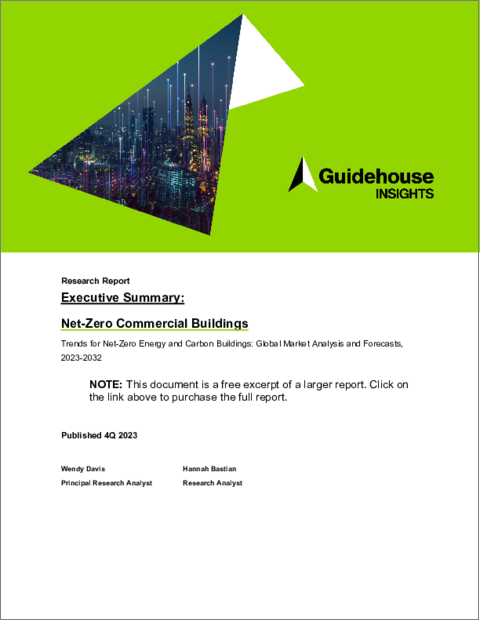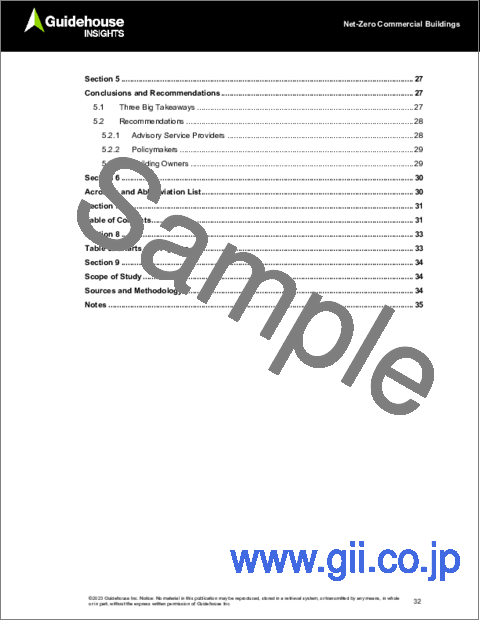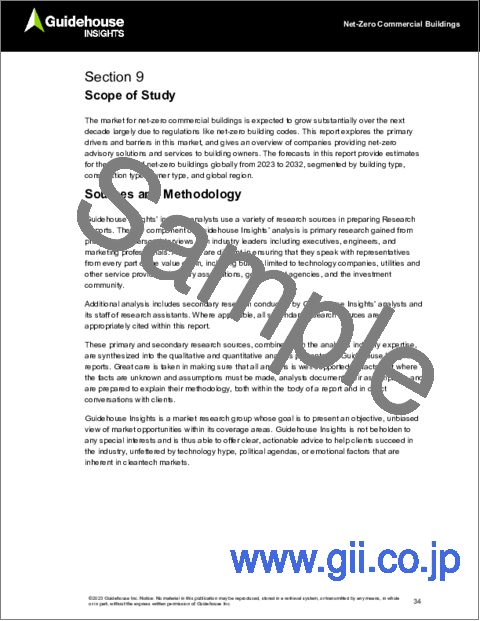|
|
市場調査レポート
商品コード
1396623
ネットゼロ商業ビル - ネットゼロエネルギー/カーボンビルの動向:世界市場の分析と予測(2023年~2032年)Net-Zero Commercial Buildings - Trends for Net-Zero Energy and Carbon Buildings: Global Market Analysis and Forecasts, 2023-2032 |
||||||
|
|||||||
| ネットゼロ商業ビル - ネットゼロエネルギー/カーボンビルの動向:世界市場の分析と予測(2023年~2032年) |
|
出版日: 2023年12月15日
発行: Guidehouse Research
ページ情報: 英文 36 Pages; 25 Tables, Charts & Figures
納期: 即納可能
|
全表示
- 概要
- 目次
世界のネットゼロ商業ビル市場は、主に欧州と北米の国や州の政府によるネットゼロ建築基準の施行により、今後10年間で劇的に成長すると予測されています。民間ビルおよび公共ビルの所有者は、将来の規制に備え、また従業員、顧客、取締役会、有権者からの圧力の高まりに対応するため、自社のビルポートフォリオでネットゼロ達成に向けたコミットメントと計画を策定し始めています。
強制的な規制や自主的な取り組みがこの市場の成長を促進する一方で、規制が発効するまでは、いくつかの障壁によって成長が比較的鈍化する可能性が高いです。1つは、ネットゼロビルの定義がまだ規制当局によって確定されていないため、将来のネットゼロ要件の見通しを理解するまで、多くのビル所有者が手探りの状態にあることです。次に、ネットゼロの達成は極めて複雑になる可能性があり、個々のビルとポートフォリオのレベルでともに目標達成に向けたもっとも費用対効果の高い戦略を実施するには、長期的な計画が必要になることが多いです。この障壁に対処するため、商業用不動産市場の既存企業の多くは、顧客のネットゼロ目標達成を支援する包括的なアドバイザリーソリューションを開発しています。
当レポートでは、世界のネットゼロ商業ビル市場について調査分析し、主な促進要因と障壁や、セグメントごとの10年間のネットゼロビル数の推計などの情報を提供しています。
目次
第1章 エグゼクティブサマリー
第2章 市場の問題
- イントロダクション
- ネットゼロの定義
- ネットゼロビルディングへの道
- 促進要因
- 政策と規制
- 公有および賃貸ビルに対する政府の取り組み
- 企業の取り組み
- 将来性
- バリア
- ネットゼロ目標の定義
- 戦略の策定と実施
- 財務会計
- 長期ビジョン
第3章 産業のバリューチェーン
- 競合情勢、ビジネスモデルの進化
第4章 市場予測
- 調査手法
- 世界の予測
- 北米
- 欧州
- その他の地域
第5章 結論、推奨事項
- 3つの大きなポイント
- 推奨事項
- アドバイザリーサービスプロバイダー
- 政策立案者
- 建物所有者
第6章 頭字語と略語のリスト
第7章 目次
第8章 図表
第9章 調査範囲、情報源と調査手法、注記
The market for net-zero commercial buildings is expected to grow dramatically over the next decade, largely due to the implementation of net-zero building codes by national and state governments across Europe and North America. Both private and public building owners are beginning to develop commitments and plans for achieving net-zero in their building portfolios, in preparation for future regulations as well as in response to growing pressure from their employees, customers, boards, and constituents.
While mandatory regulations and voluntary commitments will drive growth in this market, several barriers are likely to keep growth relatively slow until regulations take effect. For one, the definition of a net-zero building has yet to be finalized by regulators, leaving many building owners in a holding pattern until they understand the scope of future net-zero requirements. Second, achieving net-zero can be extremely complex and will often require long-term planning to enact the most cost-effective strategies for reaching the target at both the individual building and the portfolio level. To address this barrier, many existing companies in the commercial real estate market are developing comprehensive advisory solutions to help customers reach their net-zero goals.
This report evaluates the market for net-zero buildings from 2023 to 2032. It discusses key drivers and barriers and provides an overview of the types of companies that are developing net-zero advisory solutions for commercial building owners. The forecasts in this report estimate the number of net-zero buildings over a 10-year period, segmented by global region, building type, construction type, and owner type.
Table of Contents
1. Executive Summary
2. Market Issues
- 2.1 Introduction
- 2.2 Defining Net-Zero
- 2.3 Pathways to Net-Zero Buildings
- 2.4 Drivers
- 2.4.1 Policies and Regulations
- 2.4.2 Government Commitments for Publicly Owned and Leased Buildings
- 2.4.3 Corporate Commitments
- 2.4.4 Future-Proofing
- 2.5 Barriers
- 2.5.1 Defining Net-Zero Targets
- 2.5.2 Strategy Development and Implementation
- 2.5.3 Financial Accounting
- 2.5.4 Long-Term Vision
3. Industry Value Chain
- 3.1 Competitive Landscape and Business Model Evolution
4. Market Forecasts
- 4.1 Methodology
- 4.2 Global Forecasts
- 4.2.1 North America
- 4.2.2 Europe
- 4.2.3 Rest of World
5. Conclusions and Recommendations
- 5.1 Three Big Takeaways
- 5.2 Recommendations
- 5.2.1 Advisory Service Providers
- 5.2.2 Policymakers
- 5.2.3 Building Owners






